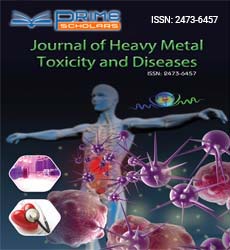Short Communication - (2024) Volume 9, Issue 6
From Shore to Sea: Investigating Heavy Metal Contamination in Marine Environments
Helen Karimi*
Department of Toxicity, Nairobi University, Kenya
*Correspondence:
Helen Karimi,
Department of Toxicity, Nairobi University,
Kenya,
Email:
Received: 02-Dec-2024, Manuscript No. ipjhmct-24-22053;
Editor assigned: 04-Dec-2024, Pre QC No. ipjhmct-24-22053 (PQ);
Reviewed: 18-Dec-2024, QC No. ipjhmct-24-22053;
Revised: 23-Dec-2024, Manuscript No. ipjhmct-24-22053 (R);
Published:
30-Dec-2024, DOI: 10.21767/2473-6457.24.6.51
Introduction
Heavy metal contamination in coastal and marine environments
is a growing global concern due to the significant ecological
and human health risks it poses. Metals like lead, mercury,
cadmium, arsenic, copper, and zinc which occur naturally in
the earth crust, can accumulate in aquatic ecosystems through
both natural and anthropogenic activities. Human activities such
as industrial discharges, mining, agricultural runoff, and urban
waste contribute substantially to the increased concentrations
of these metals in marine environments. Understanding the
sources, impacts, and mitigation strategies for heavy metal
contamination is essential for protecting both marine ecosystems
and the livelihoods of millions of people who depend on these
environments for food and income.
Description
Industries such as mining, metal processing, and chemical
manufacturing are significant contributors to heavy metal
contamination. Wastewater discharges from factories often
contain high concentrations of metals such as cadmium,
chromium, and zinc, which can be directly released into rivers or
coastal waters. Once in the water, these metals can accumulate
in the sediment, posing long-term risks to aquatic life. The use
of pesticides, fertilizers, and herbicides in agriculture can lead
to the runoff of heavy metals into nearby rivers and streams,
which ultimately flow into coastal and marine environments.
Copper and zinc are commonly found in pesticides, while arsenic
can be a contaminant in certain fertilizers. These chemicals not
only pollute the water but also degrade the soil quality and
disrupt local ecosystems. Urban areas with insufficient waste
treatment systems contribute significantly to the contamination
of marine environments. Household waste, including discarded
electronics and batteries, contains heavy metals such as lead
and mercury, which can leach into the surrounding waters.
Furthermore, untreated sewage and wastewater often contain
metals from household cleaning products and other sources.
The shipping industry, including shipwrecks, releases heavy
metals like lead and mercury into the oceans through spills, fuel
emissions, and discarded cargo. The anti-fouling paints used
on ships often contain copper, which can leach into the water
over time. Oil spills and ballast water from ships also contribute
to the introduction of toxic metals into marine ecosystems.
Heavy metals have severe and long-lasting impacts on marine
ecosystems. When these metals enter the food chain, they
can accumulate in the tissues of marine organisms, leading to
bioaccumulation and biomagnification. This means that as
smaller organisms ingest contaminated water or sediment, they
accumulate heavy metals in their tissues, which are then passed
on to predators higher up the food chain. Heavy metals can have
direct toxic effects on marine organisms, including fish, shellfish,
and invertebrates. Mercury and cadmium, for example, can
interfere with the nervous system and disrupt enzyme activity
in marine animals, leading to growth retardation, reproductive
failure, and even death. Lead can cause a range of physiological
problems, including impaired immune function and neurological
damage in marine species [1-4].
Conclusion
Heavy metal contamination in coastal and marine environments
presents significant environmental and human health challenges.
While industrial activities, agricultural runoff, and urban waste
are major contributors to this issue, understanding the sources
and impacts of contamination is the first step in mitigating
the problem. By implementing stricter regulations, adopting
cleaner technologies, and utilizing remediation methods such
as bioremediation, it is possible to reduce the harmful effects
of heavy metals on marine ecosystems. Protecting coastal environments from heavy metal contamination is essential not
only for maintaining biodiversity but also for safeguarding the
health of communities that depend on marine resources for their
livelihoods.
Acknowledgement
None.
Conflict Of Interest
The author states there is no conflict of interest.
References
- Traina A, Bono G, Bonsignore M, Falco F (2019) Heavy metals concentrations in some commercially key species from sicilian coasts : Potential human health risk estimation. Ecotoxicol Environ Saf. 168(2):466-478.
[Crossref] [Google Scholar]
- Gwimbi P, Kotelo T, Selimo MJ (2020) Heavy metal concentrations in sediments and 591 cyprinus carpio: An analysis of potential health 592 risks to fish consumers. Toxicol Rep. 7(2):475-47.
[Crossref] [Google Scholar]
- Rozanski S (2013) Fractionation of selected heavy metals in agricultural soils. Ecol Chem Eng S. 20(1):117-125.
[Crossref] [Google Scholar]
- Youssef DH, Tayel FT (2004) Metal accumulation by three Tilapia spp from some Egyptian inland waters. Chem Ecol. 20(1):61-71.
[Crossref] [Google Scholar]
Citation: Karimi H (2024) From Shore to Sea: Investigating Heavy Metal Contamination in Marine Environments. J Heavy Met Toxicity Dis. 09:51.
Copyright: © 2024 Karimi H. This is an open-access article distributed under the terms of the Creative Commons Attribution License, which permits unrestricted use, distribution, and reproduction in any medium, provided the original author and source are credited.

